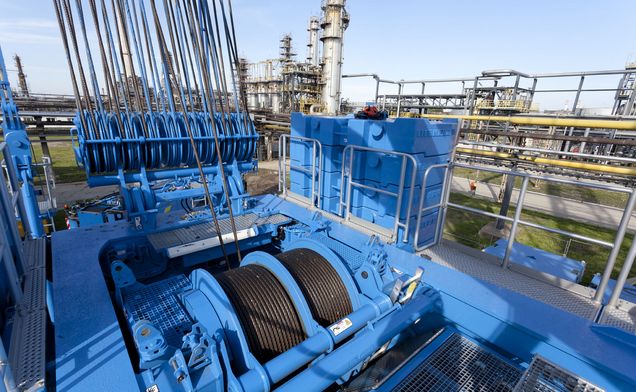Duet of the giants
July 14, 2014 | Markus Lackner
A who’s who of Felbermayr Lifting Technology was used for the turnaround at the refinery in Ploiesti, says Thomas Titura about the project for the Romanian subsidiary of Petrom. Precisely 68 cranes and 22 lifting platforms with working heights of up to 103 metres. With the mobile cranes, the range of machines extends through to the 500-tonne crane. However, the highlight among the lifting devices was the two LR 1750 machines with a maximum load-bearing capacity of 750 tonnes and the 1000-tonne LR11000 crane. Since Felbermayr has exclusively received the contract for lifting and transport work, seven heavy-duty tractor units with any low-loaders that may have been required were also in continuous operation.
Transports with obstacles
To refine their functions, the machines have to be shut down and serviced at regular intervals. This “turnaround” usually takes place every two years. In the case of the turnaround at the Petrom refinery, the work was concentrated on the FCC plant for the manufacture of hydrocarbons. Essentially, during this process, four components with unit weights of 81 to 358 tonnes are transported and lifted.Three of these four components were transported to the refinery from Buzău, a city that is located 100 kilometres away. While it was possible to transport the two heavy parts (weighing approx. 80 tonnes) using a 10-axle semi low-loader, the 32-axle series had to be used for the 358-tonne „Butylenesplitter“. “Despite the 56 metre length and a diameter of more than 4.9 metres, we were able to complete the transport of this column in just one day – even though three days were planned for it,” says Titura proudly as he goes on to explain how the company overcame one of their greatest obstacles just 30 kilometres from the refinery: “At this point in the journey, we came across a bridge that did not have the required rated load capacity, so we decided to use a pivot plate to move each of the 16 axles in a staggered formation. This meant that the load was distributed perfectly.” The total length being approx. 84 metres meant that it was still quite a feat to traverse the local roads. However, thanks to detailed studies of the route, there were no surprises and the shipments were delivered according to plan. The same was true for the delivery of the fourth column, which departed from Bucharest. We used a low-loader trailer to collect this 81-tonne component from the plant. To transport this column to the refinery too, two mobile cranes were used to transfer it onto an eight-axle semi low-loader. However, since pipe bridges with low clearance heights kept getting in the way (even in the grounds of the plant), cranes had to be used a few more times to lift the component over these obstacles. Of course, the same was true for all of the other columns too. The reactor head, which departed from Deggendorf, was also noteworthy when it came to transport. Due to its diameter of 5.44 metres, it would not fit through the gates to the plant and therefore had to be lifted over the refinery’s fence using a 500-tonne crane.
Premiere for the 1000-tonne crane
The LR11000 and an LR1750 were used to lift the column, which is 56 metres long and weighs in at 358 tonnes. “This lifting operation was preceded by numerous studies, which started around one year before the event,” says Titura. Ultimately, both cranes together had a total charge weight of 1788 tonnes. The LR11000 was transported directly to the construction site by road and sea from the Liebherr plant in Ehingen. For the 358-tonne component, a new earthquake-proof foundation was laid. According to Titura, this was necessary due to new regulations. To lift the column, the first step was to attach the hook on the LR11000 to the column head and attach the hook on the LR1750, which was being used as a tracking crane, to the lower end of the column. At this point, the cranes were able to get to work. Slowly but steadily, the reactor head was lifted into the air until it finally reached a height of approx. 68 metres. The LR1750 cautiously tracked the load and thus prevented the column (at 56 metres high) from swinging. During this process, the boom on the LR11000 reached a height of 93 metres. The LR1750 was no longer required at this point. Together with 450 tonnes of suspended ballast, 210 tonnes of revolving platform ballast and 50 tonnes of central ballast, the LR11000 was now able to turn by 180 degrees. The crane with suspended load then had to be moved by a few more metres to ensure that the column could be positioned above the foundation – accurately to within centimetres. At this point, the time had come for the precision work of lowering the load over the threaded rods. After a few hours of concentrated work by the crane operator, the job was done and the column had reached its final position, where it could be secured in place by the installers. Since the new reactor was installed parallel to the old one, it was then necessary to remove the old column and take it away from the site.
After about four weeks of intensive use of devices, the work of about 100 Felbermayr-employees was done. According to Titura, the project's success can be, to a significant degree, attributed to the excellent collaboration with other companies involved. "Since we have already been part of such maintenance work three times, we know the refinery very well," Titura continues and is glad about the excellent collaboration with OMV associate company Petrom. Incidentally, the client was very happy, too. Petrom's product manager Betram Muchan applauds Felbermayr's services: "they are professionals and can master even the most complex situations."












